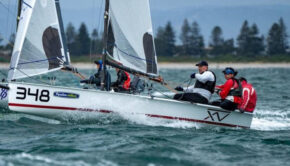Ins and Outs of Inhaulers
Published on October 3rd, 2021
Barry Hayes, Director of UK Sailmakers Ireland, takes aim at one of the hardest sail adjustments to do correctly:
Setting the inhaulers is often discussed before a race yet rarely changed on any boat once set. Maybe it’s too hard to adjust them once the sail is trimmed, or maybe they aren’t considered once the gun goes off?
Neither case is an excuse not to adjust your inhaulers in the same way you adjust your headsail leads as they are an important tool that need to be adjusted as the wind speed changes between light and heavy.
Inhaulers: how do they work?
Classic boats have long tracks on their decks along which jib cars give the proper sail shape. You know, the telltales are twittering in unison. But newer boats, particularly with non-overlapping jibs, can get an extra bit of speed by installing inhaulers that move the lead position inboard or outboard rather than just fore and aft.
Optimizing the width of the slot between the sails can do a lot for speed. Next time you sail behind some high-tech race boat, look at how close to the mast their jib is trimmed to. If they are using such tight sheeting angles, there must be some good reason to do it…and that’s not because it makes you go slower.
Inhaulers were invented to pull the clew of the genoa or headsail inboard to narrow the slot between the main and headsail. Inhauling has two main effects:
1. The tighter slot redirects the airflow around the back of the mainsail at a better angle, increasing the amount of airflow attached to the back of the main.
2. The airflow is compressed into the slot between the main and headsail. This compression and slight slowing down of the airflow forces the airflow on the leeward side of the headsail to accelerate into that void, increasing the airflow speed over the two sails much like how the airflow accelerates over the wing of a plane.
Note that when inhauling a headsail to work effectively, both the main and headsail have to be adjusted in concert, so the slot is between them is balanced. The traditional set-it-and-forget-it approach isn’t good enough any longer.
That said, compressing the airflow has both good and bad effects. Too much compression (inhauler too tight) overloads and chokes the slot. You can see this in real-time as the luff of the mainsail starts to backwind. You can use backstay to flatten the mainsail in 12+ knots to allow the slot to open, but this is not possible to do in light airs below 8 knots. You will generally notice this effect happening in the 8-12 kt range on most boats.
PRO TIP: If you feel the boat is sailing sluggish, don’t be afraid to ease the inhauler a bit and see if that increases speed.
Too little compression has the slot too open, so the airflow is not being directed around the back of the mainsail, and the symmetry of the two sails won’t be working together, causing the boat to sail slower.
Knowing how much inhauler to apply is the key; it takes time and practice to figure it out on any boat. Don’t be afraid to play with your settings during a race or while doing a boat-on-boat pre-race tune-up.
Most boats have the tracks set on the deck at about 10 degrees or more, but you will find this inefficient for racing. We inhaul to close the sheeting angle down to 7 or 8 degrees. You can easily do this on any boat by measuring the sheeting point from the centerline out to the working angle of the sail.
PRO TIP: Keep an eye on the lines that control the inhauler. They can be under significant load and may be prone to wear. So overbuild instead of underbuild this system.
An important point for the uninitiated; sheeting the inhauler in shouldn’t be made with just any headsail. The sail must be designed to have extra twist in the leech to be inhauled harder. If you don’t have the twist designed into the leech, you will completely choke the slot, and you won’t be fast.
You will notice this when you inhaul, and the leech is straight from the clew to the head because the sail wasn’t designed with extra twist in the leech. Most inhauled headsails have twist between 13 to 15 degrees.
Precisely how much you inhaul and in what conditions are different for every boat. Well, that’s the real question, isn’t it?
A boat with a long keel, for example, shouldn’t go inside 9 degrees, or the boat would stop. The speed of the boat through the water also greatly affects the inhauler. The Cape 31, for example, can go into 5 degrees as the balance of the lead allows the boat to do it.
It would help if you had a well-designed boat with the sails, keel, and rudder working perfectly together to do this angle. An older designed boat would not maintain this sheeting angle without the boat coming to a complete stop and sliding sideways. For example, a J/109 can have a sheeting angle of 7 degrees, whereas a First 44.7 would have a wider angle.












 We’ll keep your information safe.
We’ll keep your information safe.